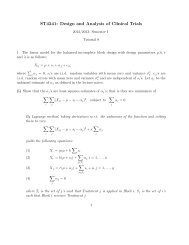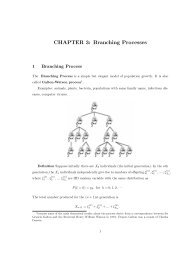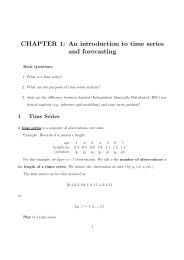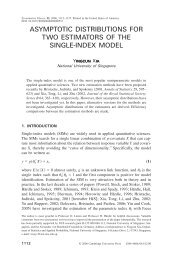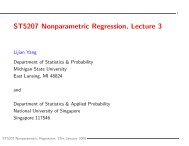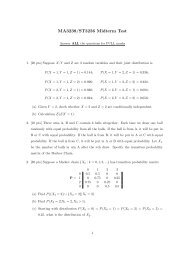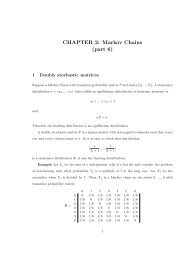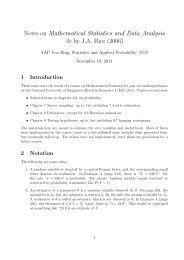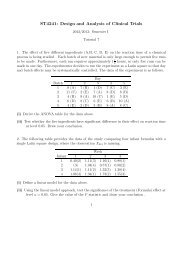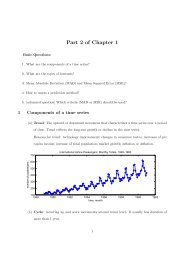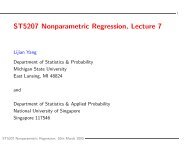2. Parallel groups design and its data analysis §2.1. Parallel groups ...
2. Parallel groups design and its data analysis §2.1. Parallel groups ...
2. Parallel groups design and its data analysis §2.1. Parallel groups ...
Create successful ePaper yourself
Turn your PDF publications into a flip-book with our unique Google optimized e-Paper software.
<strong>2.</strong> <strong>Parallel</strong> <strong>groups</strong> <strong>design</strong> <strong>and</strong> <strong>its</strong> <strong>data</strong><br />
<strong>analysis</strong><br />
§<strong>2.</strong>1. <strong>Parallel</strong> <strong>groups</strong> <strong>design</strong> <strong>and</strong> r<strong>and</strong>omization<br />
schemes<br />
The parallel <strong>groups</strong> <strong>design</strong> for comparing g treatmentsisasfollows:<br />
n (a multiple of g) patients<br />
are r<strong>and</strong>omly divided into <strong>groups</strong> of equal size,<br />
<strong>and</strong> the g treatments are r<strong>and</strong>omly assigned to<br />
the g <strong>groups</strong>.<br />
• Why is r<strong>and</strong>omization necessary?<br />
R<strong>and</strong>omization is to make the <strong>groups</strong> assigned<br />
to different treatments as homogeneous as possible<br />
so as to avoid bias.<br />
Bias might be caused by assigning a particular<br />
treatment to a particular group of patients because<br />
other considerations, such as race, severity<br />
of the disease, etc.<br />
1
When bias presents the treatment effects will<br />
be confounded with the effects of other (unknown)<br />
factors.<br />
• Simple r<strong>and</strong>omization scheme <strong>and</strong> <strong>its</strong><br />
drawbacks<br />
A simple r<strong>and</strong>omization scheme is obtained by<br />
r<strong>and</strong>omly permute the n patients <strong>and</strong> then<br />
divide the permute patients in order into g<br />
<strong>groups</strong>.<br />
An example: 45 patients are r<strong>and</strong>omly permuted<br />
<strong>and</strong> divided into 3 <strong>groups</strong>.<br />
44 42 10 21 28 38 6 31 27 30 17 35 29 41 15<br />
9 25 14 16 37 45 40 36 8 24 32 5 20 34 2<br />
33 43 13 23 12 4 1 3 18 22 11 26 19 7 39<br />
If the trials stops earlier than planned, it might<br />
result in an imbalance of patients among the<br />
<strong>groups</strong>, some bias might occur.<br />
2
• R<strong>and</strong>omly permuted blocks schemes<br />
Instead of permuting all patients together, patients<br />
are permuted in batches with size as a<br />
smaller multiple of g.<br />
The simplest one is to permute the patients in<br />
batches of size g.<br />
— This scheme is easier to implement, but<br />
might still cause bias if the trial cannot be<br />
completely double-blinded.<br />
A modified one is to permute the patients in<br />
baches of size gr with r ≤ 3or4chosenr<strong>and</strong>omly<br />
for each batch.<br />
— This scheme is a good compromise between<br />
simplicity <strong>and</strong> unbiasedness.<br />
3
§<strong>2.</strong><strong>2.</strong> Analysis of varaince <strong>and</strong> multiple<br />
comparisons<br />
• Summarization of <strong>data</strong> from a parallel<br />
<strong>groups</strong> study<br />
n i : sample size of group i,<br />
X ij : the measurement of patient j in group i.<br />
Let n· = ∑ g<br />
i=1 n i.Define<br />
¯X i = 1 ∑n i<br />
X ij , ¯X· = 1 g∑<br />
n i ¯Xi ,<br />
n i<br />
j=1<br />
n·<br />
i=1<br />
s 2 i = 1 ∑n i<br />
(X ij −<br />
n i − 1<br />
¯X i ) 2 ,S 2 = 1<br />
n· − 1<br />
i=1<br />
g∑ ∑n i<br />
(X ij − ¯X·) 2 .<br />
i=1 j=1<br />
Example: In a surgical trial involves 29 patients.<br />
Each patient received one of four anesthetics:<br />
Ether, Cyclopropane, Thiopental <strong>and</strong><br />
Spinal. The measuerment is the level of inorganic<br />
serum phosphorus after surgery.<br />
4
The <strong>data</strong> is summarized as follows:<br />
General<br />
Example<br />
Sample<br />
Sample<br />
Group size Mean Var Group size Mean Var<br />
1 n 1<br />
¯X1 s 2 1 Ether 5 4.64 1.2080<br />
2 n 2<br />
¯X2 s 2 2 Cyclo 7 4.63 0.7390<br />
. Thio 9 3.53 0.2025<br />
g n g<br />
¯Xg s 2 g Spinal 8 3.08 0.5479<br />
Total n·<br />
¯X· S 2 Total 29 3.86 0.9915<br />
• Analysis of variance — Are there differences<br />
among <strong>groups</strong>?<br />
To test whether or not there is any difference<br />
at all among different treatments, an F -test<br />
from <strong>analysis</strong> of variance is applicable.<br />
General <strong>analysis</strong> of variance table for <strong>data</strong><br />
from a parallel <strong>groups</strong> study<br />
Source Between Within Total<br />
df g − 1 n· − g n· − 1<br />
SS ∑ n i ( ¯X i − ¯X·) 2 ∑ (ni − 1)s 2 i (n· − 1)S 2<br />
MS BMS WMS<br />
F-ratio BMS/WMS<br />
5
F =BMS/WMS ∼ F g−1,n·−g.<br />
Analysis of variance table for the example<br />
Source Between Within Total<br />
df 3 25 28<br />
SS 13.04 14.72 27.76<br />
MS 4.35 0.59<br />
F-ratio 7.37<br />
P-value = P (F 3,25 > 7.37) ≈ 0.001.<br />
Conclusion: There are significant difference<br />
among the four anesthetics.<br />
• Maltiple comparison — What are the<br />
differences?<br />
After it has been confirmed that there is difference<br />
among the treatments, it is more important<br />
to find what the difference is. There are<br />
two situations: a) there are no pre-hypothesized<br />
specific differences to investigate <strong>and</strong> a general<br />
exploring needs to be made to discover<br />
6
the differences; b) there are certain scientifically<br />
important specific differences which are<br />
pre-hypothesized. Situation a) is tackled by<br />
Scheffe’s method. One case of situation b) is<br />
tackled by Tukey’s method.<br />
Scheffe’s method — general exploring<br />
A general structure of difference is expressed<br />
by a Contrast. Let μ i denote the effect of<br />
treatment i. A contrast is defined as<br />
g∑<br />
g∑<br />
C = c i μ i with c i =0.<br />
i=1<br />
i=1<br />
All contrust together describe the totality of<br />
the difference among the treatments, because<br />
of the following equivalence:<br />
7
(1)<br />
μ 1 = μ 2 = ···= μ g<br />
⇐⇒<br />
∑ g<br />
i=1 c iμ i =0 forallC.<br />
In <strong>data</strong>-snooping, it is not possible to investigate<br />
all contrasts, the contrasts of interest are<br />
often suggested by the <strong>data</strong>. For instance, in<br />
the example, some contrasts suggested by the<br />
<strong>data</strong> are:<br />
C 1 : (1, 0, −1, 0)<br />
C 2 : (0, 1, 0, −1)<br />
C 3 : (0.5, 0.5, 0, −1)<br />
C 4 : (0.5, 0.5, −0.5, −0.5)<br />
To test whether a contrast (suggested by <strong>data</strong>)<br />
is significant, the Scheffe’s method claims sig-<br />
8
nificance at level α, if<br />
where<br />
L =<br />
Ĉ =<br />
Ĉ √<br />
se(Ĉ)<br />
≥ (g − 1)F g−1,n·−g,α,<br />
g∑<br />
c i ¯Xi ,<br />
i=1<br />
se(Ĉ) = √WMS · ∑ c 2 i<br />
n i<br />
,<br />
<strong>and</strong> F g−1,n·−g,α is the upper α-quantile of the<br />
F -distribution with df g − 1<strong>and</strong>n· − g.<br />
Simultaneous Confidence Intervals:<br />
The simultaneous confidence intervals for the<br />
contrasts are constructed as<br />
Ĉ ± se(Ĉ) √(g − 1)F g−1,n·−g,α.<br />
9
Rationale of Scheffe’s method:<br />
Because of the equivalence (1), to control the<br />
Type I error of wrongly declaring significant<br />
difference among the treatments, it requires<br />
to find a c α such that<br />
P (max<br />
all C<br />
It can be shown that<br />
max<br />
all C<br />
Ĉ<br />
se(Ĉ) ≥ c α) ≤ α.<br />
(<br />
Ĉ<br />
se(Ĉ) ) 2<br />
=(g − 1) BMS<br />
WMS ,<br />
where<br />
BMS<br />
WMS ∼ F g−1,n·−g.<br />
Computation of p-values:<br />
For a particular contract, let the observed value<br />
of<br />
Ĉ<br />
se(Ĉ) be denoted by L C.Thep-value of the<br />
10
contrast is computed as<br />
P (F g−1,n·−g ≥ L 2 C /(g − 1)),<br />
where F g−1,n·−g is a r<strong>and</strong>om variable with F<br />
distribution of degrees of freedom g − 1<strong>and</strong><br />
n· − g.<br />
Testing <strong>data</strong> suggested contrasts by Scheffe’s<br />
method in the example:<br />
Ĉ se(Ĉ) L p-value<br />
1 1.11 0.428 <strong>2.</strong>59 0.1089<br />
2 1.55 0.398 3.89 a 0.0072<br />
3 1.56 0.353 4.42 a 0.0021<br />
4 1.33 0.292 4.55 a 0.0015<br />
Remark:<br />
(i). It is possilbe that the overall F -test is<br />
significant but none of the contrasts considered<br />
is significant.<br />
11
(ii). For any single contrast,<br />
Ĉ<br />
follows a<br />
se(Ĉ)<br />
t-distribution with df n· − g.<br />
(iii) If the test for each contrast is based on<br />
the t-distribution, it is possible that even if<br />
the overall F -test is not significant at level α,<br />
some of the t-tests are significant at level α.<br />
Why?<br />
Tukey’s method — pairwise comparison<br />
Tukey’s method is used for the situation that<br />
one is only concerned with pairwise differences.<br />
Define the studentized range as:<br />
√ n(max ¯Xi − min<br />
q g,n·−g =<br />
¯X i )<br />
√ .<br />
WMS<br />
According to Tukey’s criterion, the difference<br />
between group i <strong>and</strong> group j is significant at<br />
12
level α if<br />
√ n| ¯Xi − ¯X j |<br />
Q ij = √<br />
WMS<br />
when n 1 = ···= n g = n;<br />
Q ij =<br />
where ñ (H)<br />
ij<br />
otherwise,<br />
√<br />
ñ (H)<br />
ij<br />
| ¯X i − ¯X j |<br />
√<br />
WMS<br />
= 2n in j<br />
n i +n j<br />
.<br />
>q g,n·−g,α,<br />
>q g,n·−g,α,<br />
For values of q g,n·−g,α, use Table A.5 of Fleiss.<br />
13
Pairwise comparison by Tukey’s method in the<br />
example:<br />
Comparison C ij ij<br />
Q ij<br />
1vs.2 0.01 5.83 0.03<br />
1vs.3 1.11 6.43 3.66<br />
1vs.4 1.56 6.15 5.04 a<br />
2vs.3 1.10 7.88 4.02 a<br />
2vs.4 1.55 7.47 5.52 a<br />
3vs.4 0.45 8.47 1.71<br />
a Q ij >q 4,25,0.05 =3.89<br />
ñ (H)<br />
§<strong>2.</strong>3. Equality of variance, normality<br />
<strong>and</strong> transformations<br />
• Assumptions of <strong>analysis</strong>-of-variance model<br />
<strong>and</strong> consequence of their vialation.<br />
The ANOVA model assumes<br />
y ij = μ i + ɛ ij ,<br />
14
where ɛ ij are iid N(0,σ 2 ).<br />
The most important features of the normal<br />
distribution are: 1) it is symmetric about <strong>its</strong><br />
mean <strong>and</strong> 2) <strong>its</strong> variance does not depend on<br />
<strong>its</strong> mean.<br />
The tests involved in the ANOVA <strong>and</strong> multiple<br />
comparison such as F -test are robust with<br />
respect to minor departure from the normality<br />
assumption.<br />
But if the underlying distribution is seriously<br />
skewed, especially, when <strong>its</strong> variance depends<br />
on <strong>its</strong> mean, the accuracy of the tests will be<br />
adversely affected.<br />
• Transformation as a remedy.<br />
For a r<strong>and</strong>om variable with variance depending<br />
on mean, a transformation can be found<br />
15
such that the variance of the transformed variable<br />
is independent of <strong>its</strong> mean. Suppose that,<br />
for the original variable X, σ 2 = V (μ), the<br />
proper transformation is derived as<br />
∫<br />
1<br />
h(x) = √ dx.<br />
V (x)<br />
The transformation is called Variance Stablization<br />
transformation. It makes the transformed<br />
variable more like a normal variable.<br />
• Transformations for some particular<br />
responses.<br />
Proportion as response<br />
Example: Two methods are applied to train<br />
patients with senile dementia to care for themselves.<br />
After the completion of the training,<br />
patients are asked to take 20 tests involving<br />
activities of daily living. The response from<br />
16
each patient is the proportion of his or her<br />
tests that are successful.<br />
A common feature for proportions: if the mean<br />
is close to either zero or 1, the variance is<br />
smaller; if the mean is close to 0.5, the variance<br />
is larger. The variance of such response<br />
can be approximated by<br />
V (p) =cp(1 − p),<br />
where c is a constant, p is the mean proportion.<br />
The variance stablization transformation is given<br />
by<br />
h(p) =arcsin √ p.<br />
Count as response<br />
Examples: Counted number of micro-organisms<br />
in a sample of a patient’s blood or saliva; counted<br />
17
number of attacks of angina pectoris that a patient<br />
experience in a specified period of time,<br />
etc.<br />
Most count response can be approximated by<br />
a Poisson r<strong>and</strong>om variable. The variance is<br />
proportional to the mean. The variance stablization<br />
transformation is given by<br />
h(μ) = √ μ.<br />
Time to event as response<br />
Examples: disease free time after a treatment;<br />
survival times, etc.<br />
For time to event, the variance is usually dependent<br />
of mean. A reciprocal transformation<br />
is appropriate when the variance is proportional<br />
to the fourth power of the mean.<br />
The reciprocal transformation usually has a<br />
18
physical meaning, e.g., the reciprocal of time<br />
to death is the death rate, the reciprocal of<br />
time to the occurence of a reaction is the speed<br />
of the reaction, etc.<br />
Response with log transformation<br />
A log transformation is appropriate in the following<br />
situations:<br />
1. Mean values are more sensibly compared in<br />
terms of their ratios than in terms of their<br />
differences.<br />
<strong>2.</strong> The variance of the responses is proportional<br />
to the square of their mean.<br />
3. The responses have a log-normal distribution.<br />
Box-Cox transformation<br />
A general family of transformations, Box-Cox<br />
19
transformation, is given by<br />
h(μ) = μλ − 1<br />
.<br />
λ<br />
The parameter λ can be determined by the<br />
<strong>data</strong>.<br />
An example: Lysozyme levels in the gastric<br />
juice of 29 patients with peptic ulcer <strong>and</strong> of 30<br />
normal controls.<br />
Patient group:<br />
0.2 0.3 0.4 1.1 <strong>2.</strong>0 <strong>2.</strong>1 3.3 3.8 4.5 4.8 4.9<br />
5.0 5.3 7.5 9.8 10.4 10.9 11.3 1<strong>2.</strong>4 16.2 17.6 18.9<br />
20.7 24.0 25.4 40.0 4<strong>2.</strong>2 50.0 60.0<br />
Control group:<br />
0.2 0.3 0.4 0.7 1.2 1.5 1.5 1.9 <strong>2.</strong>0 <strong>2.</strong>4 <strong>2.</strong>5 <strong>2.</strong>8<br />
3.6 4.8 4.8 5.4 5.7 5.8 7.5 8.7 8.8 9.1 10.3 15.6<br />
16.1 16.5 16.7 20.0 20.7 33.0<br />
The t-test for the comparison of the two <strong>groups</strong><br />
is significant at level 0.05. But the test is<br />
doubtful.<br />
20
Mean <strong>and</strong> st<strong>and</strong>ard deviation of the two <strong>groups</strong>:<br />
¯X 1 =14.31, ¯X 2 =7.68,<br />
s 1 =15.74,s 2 =7.85.<br />
s 1 /s 2 =<strong>2.</strong>0051.<br />
The unequal st<strong>and</strong>ard deviations suggest that<br />
a transformation is in order.<br />
St<strong>and</strong>ard deviations with various<br />
transformations<br />
s 1 s 2 s 1 /s<br />
√ 2<br />
μ 1.9648 1.3649 1.4395<br />
1/μ 1.1348 1.1070 1.0251<br />
log(μ) 1.4814 1.3162 1.1255<br />
An appropriate transformation can be either<br />
the reciprocal or the log transformation. However,<br />
the t-test based on the transformed <strong>data</strong>,<br />
say, log transform, is no longer significant at<br />
level 0.05.<br />
21
§<strong>2.</strong>4. Non-parametric methods<br />
Non-parametric methods should be used if responses<br />
are non-normally distributed, especially,<br />
when the parametric tests based on the original<br />
<strong>data</strong> <strong>and</strong> on the transformed <strong>data</strong> do not coincide.<br />
Non-parametric tests are distribution-free; that<br />
is, the distribution of the test statistics does not<br />
depend on the underlying distribution of the responses.<br />
• Kolmogorov-Smirnov test<br />
This test can be used for the comparison of<br />
two <strong>groups</strong>.<br />
Test statistic:<br />
M =max<br />
x<br />
| ˆF 1 (x) − ˆF 2 (x)|,<br />
22
where<br />
ˆF (x) = 1 ∑n i<br />
n i<br />
j=1<br />
I{X ij ≤ x}, i =1, <strong>2.</strong><br />
The difference between the two <strong>groups</strong> is judged<br />
significant at level α if<br />
√<br />
n1 n<br />
M 2<br />
>κ α .<br />
n 1 + n 2<br />
Large-sample critical values for<br />
Kolmogorov-Smirnov test:<br />
α κ α<br />
0.20 1.073<br />
0.1 1.224<br />
0.05 1.358<br />
0.025 1.480<br />
0.01 1.628<br />
0.005 1.731<br />
0.0025 1.828<br />
0.001 1.949<br />
23
• Mann-Whitney-Wilcoxon <strong>and</strong> Kruskal-<br />
Wallis tests<br />
Mann-Whitney-Wilcoxon (MWW) <strong>and</strong> Kruskal-<br />
Wallis (KW) tests are based on ranks of the<br />
responses. MWW test is for the comparison<br />
of two <strong>groups</strong>. KW test is for the comparison<br />
of more than two <strong>groups</strong>.<br />
MWW test statistic is given by<br />
χmww = 12n 1n 2 ( ¯R 1 − ¯R 2 ) 2<br />
n 2· .<br />
(n· +1)<br />
KW test statistic is given by<br />
χ kw = 12 ∑ n i ( ¯R i − n·+1<br />
n·(n· +1)<br />
2 )2<br />
In the above, ¯Ri is the average ranks of the<br />
responses in group i when all the observations<br />
are ranked together.<br />
.<br />
24
If several observations are tied, each is given<br />
the average of their ranks they would have received<br />
if they had not been tied. When there<br />
are ties, the denominator of both MWW <strong>and</strong><br />
KW statistic should be adjusted by a factor f<br />
defined as<br />
∑ Ti=1<br />
t<br />
f =1− i (t i − 1)(t i +1)<br />
,<br />
n·(n· − 1)(n· +1)<br />
where T is the total number of values at which<br />
there are ties, t i is the number of ties at the<br />
ith tied value.<br />
Under null hypothesis that there is no difference<br />
among the <strong>groups</strong>,<br />
χmww ∼ χ 2 1 , χ kw ∼ χ2 g−1 .<br />
25
§<strong>2.</strong>5. Further notes<br />
• Computation issues<br />
The <strong>data</strong> analyses discussed in this chapter<br />
can be implemented in R by the following functions:<br />
t.test, lm, ks.test,<br />
wilcox.test, kruskal.test.<br />
• Multivariate responses<br />
Univariate t-test <strong>and</strong> ANOVA can be extended<br />
to the multivariate responses straightforwardly.<br />
For MANOVA (multivariate <strong>analysis</strong> of variance),<br />
see, e.g., R. A. Johnson <strong>and</strong> D. W.<br />
Wichern, Applied Multivariate Statistical Analysis,<br />
Chapter 6. (Prentice Hall).<br />
26
• Responses are categorical<br />
Generalized linear models with categorical responses<br />
are applicable, see, e.g., L. Fahrmeir<br />
<strong>and</strong> G. Tutz, Multivariate Statistical Modelling<br />
Based on Generalized Linear Models, Chapter<br />
3. (Springer)<br />
27



